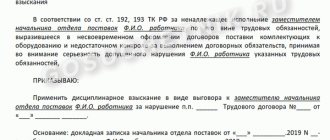Definition
Functions are a specific field of activity of an employee, the ideal result of his work, aimed at achieving overall organizational goals. These include, depending on the field of work, carrying out instructions from management, personnel records management, technical and operational control and much more. This is the expected result that an employee should bring as a result of successful performance.
Job responsibilities are specific actions performed by an employee to perform functions and achieve assigned tasks. This is a comprehensive set of processes that an employee must complete within a specified time frame and at an acceptable level of quality. Job responsibilities must be specific and outline the optimal way for the employee to perform assigned tasks.
What are job responsibilities?
Job responsibilities are certain actions that must be carried out by an employee to perform existing functions and implement the tasks assigned to him. It is also a set of types of work and processes that the worker is obliged to implement on time and at the appropriate level of quality. Depending on the position and field of work, the list of requirements may be different for everyone. So, having an idea of what functional responsibilities are, it is worth understanding identical concepts. Job responsibilities are outlined specifically and clearly, illustrating the optimal option for the employee to achieve the assigned goals.
Comparison
Thus, the key difference between these categories is the essence of the concepts. Functions are the predicted or expected result of the work of an enterprise employee. This concept is general and extremely broad. Job responsibilities are a process, both responsibilities and recommendations to the employee. They are secondary to functions and are also more detailed and specific.
Both functions and job responsibilities must be enshrined in the regulations of the organization. Going beyond the outlined limits is allowed only in special cases and, as a rule, not on the initiative of the employee.
Revision of instructions
Job descriptions are, of course, documents of long-term activity. However, due to the fact that in any organization there is an all-encompassing work with people, they can change. Revision of work instructions necessarily occurs under the following conditions:
- changes in the organizational and structural conditions of the organization’s functioning;
- reassignment of the clerical department;
- change of job title;
- introduction of additional innovative forms and methods of organizing labor relations;
- implementation of innovative technologies that allow competent and optimal distribution of responsibilities and functions between employees and departments.
https://youtu.be/gePPWHJjWEk
Now it has become clear what functional responsibilities are.
Job description and job responsibilities of the employee
When hiring, in addition to concluding an employment contract, employers often offer a new employee to read the job description. Some workers sign the instructions without reading them, while others are surprised: everything is written down in the contract, so why another piece of paper? Employers often treat job descriptions with disdain: firstly, this document is not mandatory for commercial organizations, and secondly, like employees, I sincerely do not understand why “duplicate” an employment contract. The basic rights and responsibilities of an employee are indeed enshrined in an employment contract, but it is difficult to spell out absolutely all employee’s job responsibilities in its text, and therefore they are usually formulated very vaguely. Very often, in commercial organizations there is only one standard employment contract for all employees, so in the event of a conflict it is very difficult to prove that the employee really did not fulfill his job duties. The result of such a disdainful attitude towards job descriptions is conflicts between the employee and the administration, sometimes leading to legal proceedings. So why do you need a job description? A job description is a document that can prevent all or almost all disagreements between the parties regarding job responsibilities and specify the employee’s job function as much as possible. Let’s assume that an employer fires an employee for repeated failure to fulfill job duties, which is expressed in the fact that the employee reported on the work done not in writing, but orally. The employment contract simply states: “must report”; in what exact form is not specified. Such a dismissal may well be considered illegal, since it is very problematic to prove that the employee reported (or did not report) orally. These are the specifics that should be contained in the job description. Clarification of an employee’s rights directly contributes to the high-quality performance of his job duties. For example, to complete a task from a boss, an employee needs to obtain some information from another department or service. If the employee does not have the right to receive such information, and colleagues do not provide it, then it will not be possible to punish the employee for failure to complete the task. Another question is if such a right is enshrined in his job description, but he did not use it... Here we can already talk about applying a disciplinary sanction. The main difference between a job description and an employment contract is that it is an “impersonal” document, that is, it is approved not for this specific employee, but for the position. When employees are transferred to other positions, major changes are rarely made to the employment contract, which leads to a conflict: the employee has a new position, but his job responsibilities are old.
The difference between a job description and a production job description
When managers, specialists and other employees are hired, the instructions developed for them are called job descriptions. And for worker professions, on the basis, as a rule, of uniform tariff and qualification reference books for work and worker professions in the relevant industries, production instructions are approved, which are also sometimes called work instructions. Thus, the difference between a job description and a work instruction lies only in the category of workers for whom such instructions are being developed. Although this division is quite arbitrary, because both job and work instructions must give the employee an unambiguous understanding of what work he has to do.
Sep 10, 2019adminlawsexp
Job functions or job responsibilities?
So it is very convenient to develop new job descriptions for all positions once, and then when transferring an employee, it is enough to draw up an additional agreement to the contract of two or three points and familiarize him with the job description, and not actually draw up a new contract. And from a purely technical point of view, it is much easier to make changes to a job description than to make changes to each employment contract. Typically, a job description consists of several sections: “General Provisions”, “Rights”, “Job Responsibilities” and “Responsibilities”. The section “ General Provisions ” indicates: job title; qualification requirements for the education and work experience of the employee filling this position; to whom the employee directly reports; procedure for appointment, replacement and dismissal; presence and composition of subordinates; a list of documents that the employee must follow in his activities (legislative acts of the Russian Federation, local documents, etc.). This section may include other items that clarify the employee’s status and the conditions of his activities. The “ Rights ” section contains a list of rights that an employee has when performing his official duties. Here, based on the official duties and powers assigned to him, the employee’s rights are clarified, for example, the employee’s relationships with other officials and structural divisions of the organization are reflected. Job Responsibilities section describes in more detail, compared to the employment contract, the employee’s responsibilities that are assigned to him in accordance with the performance of his job function. Responsibility section - it indicates the extent of the employee’s responsibility for failure to comply with the requirements established by the job description, other local regulations and labor legislation of the Russian Federation. Of course, nothing that goes beyond the current legislation should be contained in any section, and if it is included, it will not have legal force. A familiarization sheet is attached to the job description, which serves as proof that the employee has read it and signed it, because its requirements are mandatory for the employee holding this position from that moment on. The job description is developed by a person authorized by the head of the organization, agreed upon with the relevant legal unit (legal adviser) of the organization (if any), and, if necessary, with other units of the organization and the superior manager supervising the relevant area of the employee’s activity. The agreed and approved job description is numbered, laced, certified with the seal of the HR department and stored in the HR department or in a structural unit in accordance with the established procedure. For current work, certified copies are taken from the original job description, one of which is issued to the employee, the second to the head of the relevant structural unit. The main advantages of having job descriptions in an organization are as follows. Failure by an employee to comply with the provisions of the job description allows the employer to apply a disciplinary sanction and, as a result, dismiss the employee, and then prove in court that the disciplinary sanction for failure to fulfill official duties was imposed lawfully. The employee, in turn, will find it easier to refuse to perform work not provided for in the instructions. The presence of job descriptions can also play an important role when hiring an applicant: the legitimacy of a refusal to hire can be confirmed or refuted using the job description, comparing its requirements with the qualifications of the applicant. In addition, the instructions allow you to evenly distribute responsibilities between employees with similar positions (for example, between the chief accountant, his deputy and a simple accountant), and avoid duplication of responsibilities. And as practice shows, if an enterprise has developed job descriptions, most labor conflicts are resolved without the intervention of the court and other government bodies.
The role of internal clients/suppliers of any employee can be his immediate supervisor, direct subordinates, as well as other employees connected with him by the logic of main or auxiliary business processes. Formulating an employee’s job functions in a product form requires special skills and a reorientation of thinking from describing actions to the desired results of work. Often, this is achieved simply by reformulating the traditional functions recorded in the employee’s job description.
What is the difference between functions and job responsibilities?
The entire range of job responsibilities that will be assigned to a specific employee for a specific position are described in detail either directly in the employment contract or in the compiled job description. Functional responsibilities of a nurse The functional responsibilities of a nurse include the provision of medical services, interaction with the parties to the treatment process, participation in the creation of a safe hospital environment, and in the organization of their workspace.
Important: In addition, depending on the specifics of the medical institution, the nurse administers IVs, injections, and distributes medications prescribed to the patient by the doctor. The nurse also monitors the health status of patients and provides emergency care if necessary.
In practice, when developing departmental regulations and job descriptions, job functions and requirements can be presented in the form of two tables: SERVICE FUNCTIONS Functions Internal customers SERVICE REQUIREMENTS Requirements Internal suppliers The process of determining job functions should occur “from top to bottom”, starting from the strategic goals of the organization and ending with functions employees. In this case, the functions of the lower levels of the organizational hierarchy logically follow from the functions of the upper level and serve as the basis for their implementation.
InfoThe next step is to determine the job responsibilities of employees.
Meaning of job description
The work job description is formed to specify the functional responsibilities of the organization. It assumes:
- optimal and fair distribution of a set of functions among employees;
- ensuring the appropriate level and timeliness of implemented tasks;
- creating a favorable socio-psychological environment in the team of employees;
- preventing conflict situations;
- creation of a coherent work system and established communications between employees and departments;
- clear descriptions of employee rights;
- increasing collective and personal effectiveness and responsibility;
- introduction of methods of material and non-material incentives for employees;
- ensuring a uniform workload for workers.
Functional and job responsibilities: difference
Attention: In accordance with the professional standard of a nurse, the functionality includes interaction with patients, with ITU commissions, and with social protection institutions. The nurse forms a base of those individuals who need constant care, including systematic medical supervision and social assistance.
When an employee performs a function for which the provision of certain benefits or compensation is guaranteed (or if the work is associated with appropriate restrictions), the name of the position, profession, specialty is indicated taking into account the name provided for in the ETKS.
Classification of main responsibilities
⇐ PreviousPage 63 of 92Next ⇒Due to the small number of responsibilities directly outlined in the Constitution of the Russian Federation, it is difficult to insert them into any system and trace their subordination.
Constitutional responsibilities may arise for a citizen and (or) a person; therefore, it is possible to divide constitutional responsibilities into the responsibilities of citizens and the responsibilities of people (this should include stateless persons and foreign citizens ).
The principle of equality of duties established by Part 2 of Art. 6 of the Constitution , concerns every citizen of Russia and is directly related to equality of rights and freedoms . In practical terms, it means that no citizen should be exempted or evaded from responsibilities; this burden applies equally to all citizens.
However, a fairly large number of people who are not its citizens live in the Russian Federation. The Constitution does not exempt them from certain responsibilities (pay taxes, preserve nature), since they are entitled to many rights and freedoms. But some duties do not apply to these persons; they are characteristic only of citizens of the Russian Federation (to defend the Fatherland, etc.).
A person’s responsibilities have a natural origin, they do not stem from the fact of citizenship, but from the natural membership of an individual in society, in which only his formation as a person is possible , and in this sense they are attributive properties of the human personality. From the point of view of this classification, the constitutional responsibilities of a person in Russia include:
1) respect for the rights and freedoms of others;
2) care for children and disabled parents;
3) care for historical and cultural monuments;
4) payment of taxes and fees;
5) conservation of nature and environment.
In contrast to the duties of a person, the duties of a citizen arise from the individual’s membership in the state; they are a reflection of the state-legal quality of the individual . It does not follow from this that the duties of a citizen are only the service of the individual to the state of which he is a member; a number of duties assigned by the Constitution of the Russian Federation to a citizen presuppose that in the process of their implementation he acts on behalf of the state, and such implementation itself is in the nature of state activity. From a formal legal point of view, the constitutional duties of a citizen of the Russian Federation include:
1) compliance with the Russian Constitution and laws (although this obligation also applies to foreign citizens and stateless persons, since it cannot be allowed that anyone living in the country does not comply with the laws);
2) defense of the Fatherland.
As S.A. writes Avakyan, in other cases, responsibilities that develop rights and freedoms are specifically enshrined in the norms of the Constitution together with these rights and freedoms. For example, in Part 2 of Art. 38 of the Constitution of the Russian Federation says: “Caring for children, their upbringing is the equal right and responsibility of parents,” and Part 3 of the same article says: “ Able-bodied children who have reached the age of 18 must take care of disabled parents.”
Along with this, some articles of the Constitution of the Russian Federation are specifically devoted only to the duties of citizens. We are talking about the following constitutional duties:
1) the obligation of state authorities, local governments, officials, citizens and their associations to comply with the Constitution of the Russian Federation and laws (Part 2 of Article 15);
2) the obligation to pay legally established taxes and fees (Article 57);
3) the duty to preserve nature and the environment, to take care of natural resources (Article 58);
4) duty to defend the Fatherland (Article 59).
Responsibilities are divided into natural-legal , the bearers of which are the individual and society , and legal , the bearers of which are the citizen, the state, its bodies and which are reflected in positive law .
Natural duties correspond to basic natural human rights (the right to life is the duty “thou shalt not kill”, the right to property is the duty “thou shalt not steal”). They, like natural rights, are gradually enshrined in the form of legal obligations in legislation as society develops. So, in Art. 58 of the Constitution of the Russian Federation enshrines the obligation of everyone to preserve nature and the environment, to treat natural resources with care . This duty stems from the natural right of the individual to a favorable environment (Article 42) .
It should be noted that the current Constitution of the Russian Federation does not have a special chapter devoted to the responsibilities of the individual. Chapter 2 of the 1993 Constitution, which regulates the legal status of man and citizen, is called “Rights and freedoms of man and citizen .” At the same time, the basic norms establishing the responsibilities of man and citizen are also enshrined in this chapter. We can agree that this is a definite violation of the rules of legal technique (especially since Article 64 , which concludes Chapter Two, states that “the provisions of this chapter constitute the foundations of the legal status of an individual ”). Let us assume that this state of affairs is partly explained by the fact that some of the duties are closely related to the corresponding rights, as well as an attempt to once again emphasize the priority position of human rights and freedoms in comparison with public and state interests, which are fixed, among other things, in duties.
Due to the indicated deficiency in the title of Chapter 2 and the wording of the first sentence
of Art. 18 of the Constitution of the Russian Federation, constitutional duties, unlike rights and freedoms,
are not classified as directly applicable.
One can agree with the authors who believe that in practice this contributes to ignoring constitutional duties and abuse of constitutional rights and freedoms
.
Meanwhile, without the duties of an individual, its constitutional status cannot be understood in practice. Therefore, in my opinion, the Constitution of the Russian Federation should establish that
not only rights and freedoms, but also responsibilities directly applicable in Russia . Also, in this regard, it would be logical to call this chapter of the Constitution of the Russian Federation “Rights, freedoms and responsibilities of man and citizen ,” which will make it possible to reflect with a greater degree of clarity and completeness the totality of integral elements of the constitutional status of man and citizen. ⇐ Previous63Next ⇒
Job functions or job responsibilities?
Catalog of competitions! The development of labor relations has led to the fact that the range of powers and competencies of each employee has received a precise definition. Management sometimes forces its employees to go beyond their job duties and perform functions that are unusual for them.
A precise delineation of concepts will help employees of organizations better understand their rights and, accordingly, defend them with reason. How do functions differ from job responsibilities? What are functions and job responsibilities? Functions are a specific field of activity for an employee, the ideal result of his work, aimed at achieving overall organizational goals. These include, depending on the field of work, carrying out instructions from management, personnel records management, technical and operational control and much more.
The concept and types of constitutional duties of a person and a citizen
The constitutional duties of a person and a citizen are state-authoritative requirements for an individual regarding the type and extent of his proper behavior established in accordance with the needs of the development of society and the state by the Constitution of the Russian Federation. They are the second integral part of the “core” of the constitutional position of the individual.
The Constitution of the Russian Federation does not contain a detailed list of duties, although ideally it is assumed that each subjective right has a corresponding legal duty. Such compliance is achieved by securing specific responsibilities not only by the Constitution of the Russian Federation, but also (mainly) by Russian laws, i.e. by establishing legal responsibilities in a broad sense.
The Constitution of the Russian Federation establishes the following duties:
— the duty of a person and a citizen, when exercising their rights and freedoms, not to violate the rights and freedoms of other persons (Part 3 of Article 17);
— Human responsibilities in the form of the obligation of parents to take care of children, their upbringing and the obligation of able-bodied children who have reached the age of 18 to take care of disabled parents (parts 2 and 3 of Article 38);
- the obligation of everyone to receive basic general education and the obligations of parents or persons replacing them to ensure that their children receive such an education (Part 4 of Article 43)
- the obligation of everyone to take care of the preservation of historical and cultural heritage, to protect historical and cultural monuments (Part 3 of Article 44),
- the obligation of everyone to pay legally established taxes and fees (Article 57)
— the obligation of everyone to protect nature and the environment, to take care of natural resources (Article 58)
— the duty of a citizen of the Russian Federation to defend the Fatherland (Part 1, Article 59).
The absence of a wide list of constitutional duties is caused by the tradition of enshrining in constitutions, first of all, rights and freedoms, the establishment of a universal constitutional duty of citizens to comply with the Constitution of the Russian Federation and laws (Part 2 of Article 15), and an emphasis on enshrining the most socially significant duties of a person and a citizen.
At the same time, it requires clarification that the universal duty of citizens to comply with the Constitution of the Russian Federation and laws implies a broader interpretation:
1. firstly, not only the actual norms of the Constitution of the Russian Federation and the laws of the Russian Federation must be observed, but also federal by-laws, constitutions, charters, laws and by-laws of the constituent entities of the Federation, acts of local governments adopted on the basis of the federal Constitution;
2. secondly, this obligation applies not only to citizens of the Russian Federation, but also to every person within the scope of the Constitution of the Russian Federation, including a citizen of a foreign state living in Russia, a stateless person.
It is also important to note that the obligation to comply with the Constitution of the Russian Federation means, in essence, the obligation to comply with the foundations of the constitutional system and all the variety of fundamental provisions that form the basis of the legal status of the individual, social and state system.
28. Constitutional guarantees of human and civil rights and freedoms: concept, types, legal support.
Guarantees mean the conditions created by the state and the means it uses (economic, political, legal) aimed at providing a person and citizen with a real opportunity to exercise their rights and freedoms .
The subject of the study of constitutional law is legal guarantees, that is, guarantees enshrined in legal norms.
The most general guarantee of rights and freedoms is the provision formulated in the Constitution on state protection of rights and freedoms , which does not exclude the right of citizens to independently defend their rights and freedoms by all means not prohibited by law.
The right to judicial protection occupies a central place in the system of legal guarantees. The Constitution of the Russian Federation (Part 1 of Article 46) guarantees everyone judicial protection of their rights and freedoms. The object of appeal to the court may be: decisions, actions (inaction) of state authorities, local governments, public associations and officials.
The Constitution gives everyone the right to seek protection from interstate bodies for the protection of human rights and freedoms (Part 3 of Article 46). The conditions necessary for the implementation of this right are: the existence of a corresponding international treaty of the Russian Federation and the exhaustion of all available domestic remedies. International bodies for the protection of human rights include the UN Human Rights Committee, the European Commission of Human Rights, the European Court and many others.
This is interesting: Application for compensation for unused vacation
The Constitution of the Russian Federation contains so-called guarantees of the administration of justice, aimed at eliminating arbitrariness in judicial proceedings. These, in particular, include guarantees of jurisdiction (Article 47), presumption of innocence (Article 49), inadmissibility of repeated conviction for the same crime (Article 50), the right to qualified legal assistance (Article 48) and others .
Among the institutions that guarantee rights and freedoms is the widely spread institution of the parliamentary Commissioner for Human Rights (Ombudsman). The ombudsman institution first appeared in 1809 in Sweden and currently operates in more than 40 countries.
The 1993 Constitution of the Russian Federation for the first time provided for the introduction in Russia of the post of Commissioner for Human Rights. Its legal status is determined by the Federal Constitutional Law of February 26, 1997 “On the Commissioner for Human Rights in the Russian Federation.”
Functional responsibilities of an employee: difference from job responsibilities
- not “organizing effective commercial activities”, but “increasing the marginal profitability of the enterprise” - for the commercial director;
- “not cleaning the office”, but “constantly maintaining cleanliness and order in the premises” - for the cleaning lady;
- not “carrying out maintenance and repair of equipment”, but “reducing the number of equipment failures in the workshop” - for a mechanic;
- not “preparing and conducting employee training programs”, but “fulfilling orders from workshops to train workers and craftsmen for the production of new products” - for the HR manager;
- not “maintaining a database of product balances in the warehouse”, but “ensuring that information about product balances in the 1C database corresponds to the actual quantity of goods in the warehouse” - for the warehouse manager, etc.
Similar examples can be selected for any position in the organization.
Functional responsibilities
It is worth considering that the name of the position (specialty, profession) for an employee is considered one of the characteristics of the labor function. The direct functionality of employees is specified by the job responsibilities assigned to them.
https://youtu.be/5jKYfPKdxAE
These responsibilities are considered the content of the labor function. Therefore, functional responsibilities are included in the employment contract, and it is rational to indicate them in detail in the job description.
https://youtu.be/LRUvTbDpZeU
The definition of an employee’s labor function is contained in Articles 15, 57 of the Labor Code of the Russian Federation. Work in the relevant specialty or position in accordance with the staffing schedule. According to this definition, all work performed must be documented.
Responsibilities to comply with the Constitution of the Russian Federation and other state laws
Article 15 of the Constitution of the Russian Federation indicates that government bodies, as well as their branches and local representatives, individuals/legal entities bear the responsibility to comply with the Constitution of the Russian Federation and other state laws. Thus, this obligation applies to all subjects of modern legal relations.
Note 1
This obligation entails not only compliance with modern Russian legislation, but also, in a number of cases, imposes a number of responsibilities on certain categories of citizens to monitor its compliance.
Finished works on a similar topic
- Course work Types of constitutional duties 410 rub.
- Abstract Types of constitutional duties 270 rub.
- Test work Types of constitutional duties 200 rub.
Receive completed work or specialist advice on your educational project Find out the cost











